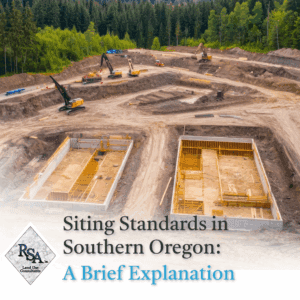One of the most important yet often misunderstood parts of developing or improving property in Jackson County is complying with siting standards. These rules, defined in Chapter 7 of the Jackson County Land Development Ordinance (LDO), ensure that structures and developments are placed in ways that promote safety, preserve community character, and protect the region’s natural resources. For property owners and developers alike, understanding siting standards in Southern Oregon is a crucial step toward a smooth, compliant project.
 Siting standards determine where and how a structure may be placed on a parcel of land. They address building setbacks, lot coverage, access points, height limitations, and a site’s relationship to natural features such as slopes, waterways, and vegetation. In Jackson County, the aim is to balance private property rights with responsible growth, environmental protection, and public safety.
Siting standards determine where and how a structure may be placed on a parcel of land. They address building setbacks, lot coverage, access points, height limitations, and a site’s relationship to natural features such as slopes, waterways, and vegetation. In Jackson County, the aim is to balance private property rights with responsible growth, environmental protection, and public safety.
At their core, siting standards help achieve several goals:
- Minimizing impacts on neighboring properties.
- Preserving scenic views and natural landscapes.
- Reducing erosion and stormwater runoff.
- Ensuring safe and logical access to public roads.
- Protecting floodplains, riparian areas, and wildlife habitat.
The Role of Chapter 7 in the Land Development Ordinance
Chapter 7 of the Jackson County LDO provides detailed guidance on how siting rules apply across different zoning districts, from urban neighborhoods to rural resource lands. It establishes general property standards and adds specialized provisions based on zoning or environmental sensitivity. Residential lots, for example, must meet minimum setbacks from property lines and streets. Commercial and industrial sites may require screening or buffers to reduce impacts on adjacent homes. Rural and resource zones include additional restrictions to protect farmland, forestland, and open space from incompatible development.
The ordinance also accounts for topographical and environmental factors. It discourages development on steep slopes to limit landslide risk and erosion. It maintains setbacks from creeks, rivers, and wetlands to safeguard water quality. It encourages minimizing disturbance to native vegetation and wildlife corridors. In short, Chapter 7 functions as a blueprint for where and how development can occur responsibly throughout Jackson County.
Why Siting Standards Matter
For landowners, understanding siting standards is about more than following rules. It protects investment value and helps avoid costly mistakes. A structure that violates setbacks or encroaches on a protected area can trigger enforcement actions, delayed permits, redesigns, or even removal. Beyond compliance, well-sited buildings are less likely to face drainage problems, soil instability, or access challenges. They also contribute to the overall quality and aesthetic of neighborhoods and rural landscapes that make Southern Oregon such a desirable place to live and work.
Applying the Standards to Real Projects
Applying siting standards begins with carefully reviewing zoning, topography, and existing site conditions. Depending on a parcel’s characteristics, additional studies may be required, such as slope analysis, floodplain delineation, or environmental review. A property near a creek must meet riparian setback requirements designed to protect waterways. A hillside lot may face grading limits to prevent excessive soil disturbance. A rural homesite on resource land must meet separation distances from agricultural or forestry operations. Thoughtful planning early in the process helps avoid surprises later and keeps projects on schedule.
Balancing Development and Preservation
Southern Oregon’s landscapes are a core community asset; the county’s siting standards help maintain that value. The LDO protects natural features while supporting responsible growth by guiding where and how structures are placed. Creative site planning that follows the land’s natural contours, retains vegetation where feasible, and respects neighboring uses can produce projects that are both compliant and compelling. In this way, siting standards do more than prevent problems. They encourage quality design and long-term stewardship of the land.
How Richard Stevens & Associates Can Help
Navigating siting standards in Southern Oregon can feel complex without the right expertise. Each project carries unique challenges tied to setbacks, slopes, access, or environmental constraints. A qualified land use planning consultant can save time, reduce risk, and provide confidence that your development meets every applicable standard. Richard Stevens & Associates offers comprehensive site analysis, clear documentation, and coordination with county planning staff to keep your project compliant and moving forward. From single homes to commercial sites and subdivisions, our team helps clients align their vision with Chapter 7 of the Jackson County LDO and the broader goals of responsible development.
If you are planning a project in Jackson County, consider engaging our professional guidance early. With a clear understanding of siting standards in Southern Oregon and a practical strategy for applying them, you can protect your investment, respect the landscape, and bring your project to life with fewer delays.
